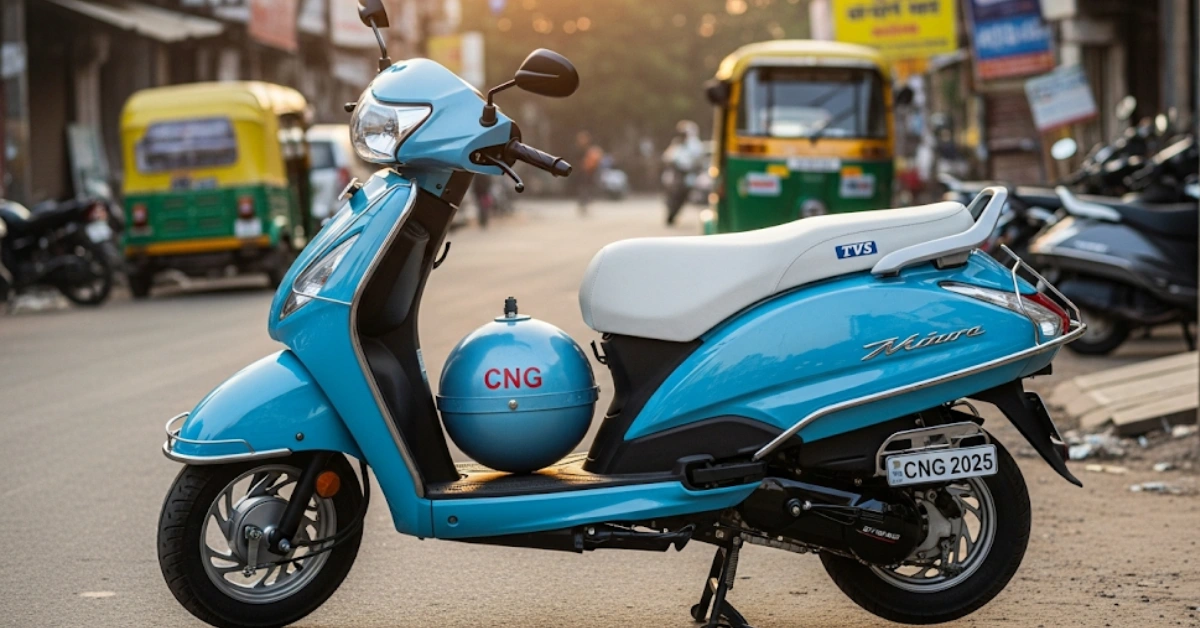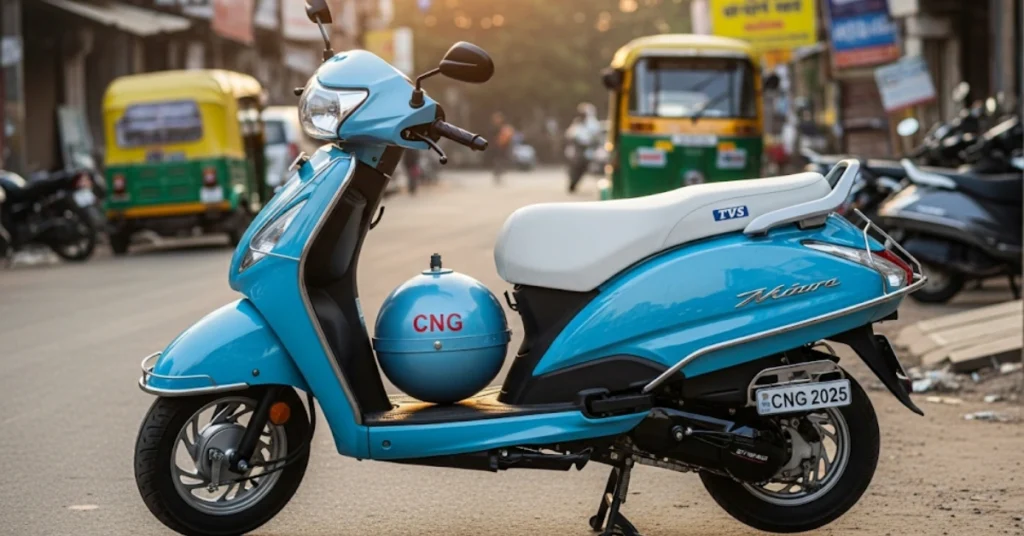The TVS Jupiter CNG 2025, recently updated for Indian roads, marks a significant step towards sustainable urban mobility. Built for riders who want affordability, low running costs, and reduced emissions, this scooter comes with a factory-installed CNG system. With prices ranging from Rs. 90,000 to Rs. 1.00 lakh (ex-showroom), it directly targets value-conscious buyers while competing with conventional petrol scooters and newer electric options. By combining eco-friendly fuel technology with practical features, it sets out to become one of the most efficient two-wheelers for everyday use. This review covers its pricing, design, performance, and key features.

Practical and Stylish Design
The Jupiter CNG 2025 retains a user-friendly family scooter look built on a durable steel frame. Measuring 1848 mm in length, 680 mm in width, and 1286 mm in height, it weighs nearly 120 kg. Ground clearance stands at 163 mm, making it fit for city bumps and speed breakers. It is rated IP54 for dust and splash resistance. Buyers can choose from Titanium Grey, Dawn Orange, Pristine White, and IndiBlue shades. A sharp LED headlamp and 12-inch alloy wheels give it a premium touch, though the under-seat storage space is reduced due to the CNG tank.
Modern Instrument Cluster
The scooter is fitted with a digital-analogue console that supports Bluetooth via SmartXonnect. Riders can access navigation, call alerts, and ride statistics on the multi-function LCD. The cluster also displays CNG pressure, fuel levels, and trip information—making it easy to track fuel usage. The interface is clear and responsive, suiting the needs of daily commuters.
Efficient and Balanced Performance
At its core, the Jupiter CNG runs on a 124.8cc BS6-compliant single-cylinder engine, delivering around 7.2 bhp and 9.4 Nm torque. Mated to a CVT gearbox, it supports both petrol and CNG fuels. The mileage claim stands at 84 km/kg on CNG, with an overall range of 226 km when combined with its 2-liter petrol reserve. A 1.4 kg CNG tank is standard. This dual-fuel system makes it highly practical for city usage where both economy and convenience matter.
Safety Systems
Unlike high-end scooters with cameras or sensors, the Jupiter CNG 2025 sticks to essential safety elements. It comes with a combined braking system (CBS) for better stopping control and a side-stand cut-off to prevent mishaps. These standard features make it compliant with urban riding safety norms.
Long-Running Fuel Setup
The scooter is equipped with a 1.4 kg CNG tank (around 9.5 liters capacity) and a 2-liter petrol tank. Together, they deliver a mixed riding range of nearly 226 km, covering about 100–120 km solely on CNG. Refueling is quick, usually between 5–10 minutes, but the availability of CNG pumps remains a deciding factor for many buyers.
Connectivity and Everyday Features
Riders get LED lighting, USB charging, and Bluetooth pairing as part of the package. Tubeless tires add convenience, while the CBS and Find My Vehicle features enhance safety. However, there is no built-in audio system or AUX input, keeping the setup simple.
Price and Buying Options
The TVS Jupiter CNG is priced at Rs. 90,000 for the base variant and Rs. 1.00 lakh for the top model (ex-showroom). On-road pricing in Delhi falls between Rs. 1.05 lakh and Rs. 1.15 lakh, including registration charges of around Rs. 7,000–8,000 and insurance costs of Rs. 5,000–6,000. Official sales began in November 2025. Buyers can expect promotional offers such as 5–10% cashback and EMI options without extra interest. Annual maintenance is estimated between Rs. 2,000–3,500, while the warranty covers 3 years or 30,000 km.
User Experience and Limitations
Owners have appreciated its low running expenses, environment-friendly fuel option, and practical design. The highlight is the impressive 84 km/kg mileage, which significantly reduces costs over time. On the downside, its drawbacks include:
-
Reduced storage space due to the CNG cylinder.
-
Dependence on CNG availability in cities.
-
Average power output compared to petrol-only rivals.
Market Comparison
Positioned in the Rs. 90,000–1.20 lakh price range, it competes with standard petrol scooters and entry-level EVs. Its fuel efficiency and eco-friendly credentials stand out, but storage limitations and modest power output place it behind some competitors in overall versatility.
Hi, my name is Hussain, the author behind Nirmalahss. I’ve always been passionate about exploring the latest in technology and automobiles, and this platform is my way of sharing that passion with others. Over the years, I’ve followed new gadgets, software trends, and the ever-changing auto industry closely, which has helped me develop a strong understanding of what truly matters to everyday users.

